Microplastic Pollution in Green Shells in Aquatic Ecosystems: A Literature Review of Determinant Factors and Management

Introduction: Water territories produce a large number of biota worldwide. The imbalance in conserving aquatic ecosystems, along with the increasing disposal of waste into the environment, has resulted in the risk of contamination of the environment and the resulting biota. The dangers of waste disposal into water can destroy the ecosystem and affect the usability of water for the environment and human beings. Discussion: The PRISMA method was used in this literature review, which examined 35 articles: 23 articles from ScienceDirect, 10 articles from Proquest, and 2 articles from PubMed. Data were analyzed by synthesizing the research variables compared with theory and then presented in the form of tables and figures. The results of this study are presented with a complete narrative description of three sub-discussions, which consisted of the characteristics of microplastics in green mussels (color, shape, size, and abundance). The color was acquired in the dark, with the predominant form of fibers <1 mm in size, which determined the amount of microplastics in green mussels induced by both human and industrial activities, as well as countermeasures through filtration of industrial effluents, the utilization of organic plastics, and policy enforcement. Conclusion: Microplastics found in green mussels in Asian waters vary in their characteristics, with the main determinants of human and industrial activities as well as multi-sectoral countermeasures.
Barboza LGA. Effects of Microplastics on Marine Organisms and Implications to Animal, Environmental and Human Health. 2019. Portugal: Institut Sains Bioperubatan Abel Salazar
National Waste Management Information System. Waste Management. Jakarta: National Waste Management Information System; 2022. https://sipsn.menlhk.go.id/sipsn/
Asia, Arifin MZ. Dampak Sampah Plastik Bagi Ekosistem Laut. Buletin Matric. 2017;14(1):44–48. http://www.poltekkp-bitung.ac.id/batampung/file/7-pi-sampah-plastik.pdf
Ramadhani DY, Agusman F, Hadi R. Karakteristik, Dukungan Keluarga dan Efikasi Diri pada Lanjut Usia Diabetes Mellitus Tipe 2 di Kelurahan Padangsari, Semarang. Jurnal Ners Lentera. 2016;4(2):142–151. http://jurnal.wima.ac.id/index.php/NERS/article/view/877
Kataoka T, Nihei Y, Kudou K, Hinata H. Assessment of the Sources and Inflow Processes of Microplastics in the River Environments of Japan. Environment Pollution Journal . 2019;244(1):958–965. https://doi.org/10.1016/j.envpol.2018.10.111
Tuhumury N, Ritonga A. Identification of Existance and Type of Microplastics in Cockle at Tanjung Tiram Waters, Ambon Bay. Jurnal TRITON. 2020;16(1):1-7. https://doi.org/10.30598/TRITONvol16issue1page1-7
Wahdani A, Yaqin K, Rukminasari N, Suwarni, Nadiarti, Dwi FI, et al. Microplastics Concentration on Manila Clam Venerupis Philippinarum in Maccini Baju Waters, Labakkang District, Pangkajene Kepulauan Regency, South Sulawesi (in Bahasa). Maspari Journal. 2020;12(2):1–13. https://www.researchgate.net/publication/344706808KONSENTRASI
Jekel M, Anger P, Bannick CG, Barthel A-K, Braun U, Braunbeck T, et al. Mikroplastik im Wasserkreislauf : Probennahme, Probenaufbereitung, Analytik, Vorkommen und Bewertung. 2020. Jerman: Technical University of Berlin University. http://dx.doi.org/10.14279/depositonce-10406
Djunaidah SI. Tingkat Konsumsi Ikan di Indonesia : Ironi di Negeri Bahari. Jurnal Penyuluhan Perikanan dan Kelautan. 2017;11(1):12–24. https://doi.org/10.33378/jppik.v11i1.82
Riska R, Ramadani F, Purwasih R. Analisis Pengembangan Wisata Bahari Pantai Apparalang di Bulukumba. Sensiste. 2020;3(1):93–97. Seminar Sains dan Teknologi Kelautan. https://doi.org/10.20956/sensistek.v3i1.13247
Dewi AP, Sunarti S. Keberadaan Permukiman Kumuh Tambak Lorok Kota Semarang terhadap Pengembangan Kampung Wisata Bahari. Jurnal Teknik PWK (Perencanaan Wilayah Dan Kota). 2019;8(1):1–11. https://doi.org/10.14710/tpwk.2019.23276
Ambarwati R, Setiawan F, Munir M. Analisis Kesesuaian Wisata Bahari Ditinjau dari Parameter Fisik Kualitas Perairan Serta Persepsi Pengunjung di Pantai Pasir Panjang Desa Wates Kecamatan Lekok Pasuruan Jawa Timur. Skripsi. Surabaya: Universitas Islam Negeri Sunan Ampel; 2021
Ashuri A, Kustiasih T. Timbulan dan Komposisi Sampah Wisata Pantai Indonesia, Studi Kasus: Pantai Pangandaran. Jurnal Permukiman. 2020;15(1):1-9. https://doi.org/10.31815/jp.2020.15.1-9
Febri SP. Analisis Kesadaran Masyarakat di Pemukiman Nelayan Kuala Langsa terhadap Dampak Pembuangan Limbah Domestik pada Perairan Pantai dan Laut. Jurnal Ilmiah Samudra Akuatika. 2017;110(9):1689–1699. https://www.ejurnalunsam.id/index.php/jisa/article/view/367/273
Suharsono M, Ikhtiar M, Baharuddin A. Analisis Spasial Risk Assesment dan Identifikasi Mikroplastik dan Keberadaan Pseudomonas Sebagai Bioremidiasi di Perairan Kota Makassar. Journal of Aafiyah Health Research. 2021;2(1):69-83. https://www.neliti.com/id/publications/558032/analisis-spasial-risk-assesment-dan-identifikasi-mikroplastik-dan-keberadaan-pse
Hasibuan NH, Suryati I, Leonardo R, Risky A, Ageng P, et al. Analisa Jenis, Bentuk dan Kelimpahan Mikroplastik di Sungai Sei Sikambing Medan. Jurnal Sains dan Teknologi. 2020;20(2):108-115. http://dx.doi.org/10.36275/stsp.v20i2.270
Rahim Z, Zamani NP, Ismet MS. Kontaminasi Mikroplastik pada Perna viridis di Teluk Lampung. Jurnal Kelautan Tropis. 2022;25(1):48–56. https://doi.org/10.14710/jkt.v25i1.12722
Kurniawan RR, Suprijanto J, Ridlo A. Mikroplastik Pada Sedimen di Zona Pemukiman, Zona Perlindungan Bahari dan Zona Pemanfaatan Darat Kepulauan Karimunjawa, Jepara. Buloma. 2021;10 (2):190-195. https://doi.org/10.14710/buloma.v10i2.31733
Alpiansyah B, Amin B, Galib M. Identification of Microplastic Type and Abundance in East Coast of Karimun Besar Island, Riau Islands. Journal of Coastal and Ocean Sciences. 2021;2(2):104–110. https://doi.org/10.31258/jocos.2.2.104-110
Hafitri M, Kurnia MU, Permata L, Yuniarti MS. Analisis Jenis Mikroplastik pada Sedimen Dasar Perairan Pulau Untung Jawa, Kepulauan Seribu, DKI Jakarta. Journal Indonesia Sosial Sains. 2022;3(3):443–454. https://doi.org/10.59141/jiss.v3i03.551
Nor NHM, Obbard JP. Microplastics in Singapore's Coastal Mangrove Ecosystems. Marine Pollution Bulletin. 2014;79(1-2):278-283. https://doi.org/10.1016/j.marpolbul.2013.11.025
Mathalon A, Hill P. Microplastic Fibers in The Intertidal Ecosystem Surrounding Halifax Harbor, Nova Scotia. Marine Pollution Bulletin. 2014;81(1):69–79. https://doi.org/10.1016/j.marpolbul.2014.02.018
Oanh DT, Thuy DT, Huong NTH, Qyunh HT, Nguyet VT, Nam PN, et al. Efficiency Assessment of Microplastic Extraction from Green Mussel Perna viridis Linnaeus. Academia Journal of Biology. 2021;43(4):55–66. https://doi.org/10.15625/2615-9023/16153
Hanif KH, Suprijanto J, Pratikto, Ibnu P. Identifikasi Mikroplastik di Muara Sungai Kendal, Kabupaten Kendal. Journal of Marrine Research. 2021;10(1):1–6. https://doi.org/10.14710/jmr.v9i2.26832
Nikmah H. Identifikasi Kelimpahan Mikroplastik dalam Air, Sedimen, dan Udang Vannamei. Skripsi. Jakarta: Universitas Islam Negeri Syarif Hidayatullah; 2022
GESAMP. Guidelines for the Monitoring and Assessment of Plastic Litter In The Ocean Reports and Studies 99. United Kingdom: United Nations Environment Programme (UNEP); 2019. https://wedocs.unep.org/20.500.11822/30009
Hiwari H, Purba NP, Ihsan YN, Yuliadi LPS, Mulyani PG. Kondisi Sampah Mikroplastik di Permukaan Air Laut Sekitar Kupang dan Rote, Provinsi Nusa Tenggara Timur. Pros Sem Nas Masy Biodiv Indon. 2019;5(2):165-171. https://smujo.id/psnmbi/article/download/3231/2649/4496
Dekiff JH, Remy D, Klasmeier J, Fries E. Occurrence and Spatial Distribution of Microplastics in Sediments from Norderney. Environmental Pollution. 2014;186(1):248–256. https://doi.org/10.1016/j.envpol.2013.11.019
Cauwenberghe VL, Colin RJ. Microplastics in Bivalves Cultured for Human Consumption. Environmental Pollution. 2014;193(1):65–70. https://doi.org/10.1016/j.envpol.2014.06.010
Yona D, Zahran MF, Fuad MAZ, Prananto YP, Harlyan LI. Mikroplastik di Perairan: Jenis, Metode Sampling, dan Analisis Laboratorium. Malang: UB Press; 2021.
Brate ILN, Hurley R, Iversen K, Beyer J, Thomas KV, Steindal CC, et al. As Sentinel for Monitoring Microplastic Pollution in Norwegian Coastal Waters: A Qualitative and Quantitative Study. Environmental Pollution. 2018;243(Part A):383-393. https://doi.org/10.1016/j.envpol.2018.08.077
Hanum SH, Darubekti N. Prevalensi Lansia Sukses dan Hubungannya dengan Faktor Sosiodemografi di Pedesaan Pesisir. Prosiding Seminar Nasional Penelitian. 2021;1(1):1-6. https://jurnal.umj.ac.id/index.php/semnaslit/article/view/10614
Ramli R, Yaqin K, Rukminasari N. Microplastics Contamination in Green Mussels Perna viridis in Pangkajene Kepulauan Waters, South Sulawesi, Indonesia. Akuatikisle. 2021;5(1):1–5. https://doi.org/10.29239/j.akuatikisle.5.1.1-5
Emadian SM, Onay TT, Demirel B. Biodegradation of Bioplastics in Natural Environments. Waste Management. 2017;59(1):526–536. https://doi.org/10.1016/j.wasman.2016.10.006
Zhang W, Zhang S, Wang J, Wang Y, Mu J, Wang P, et al. Microplastic Pollution in the Surface Waters of the Bohai Sea, China. Environment Pollution. 2017;231:541–548. http://dx.doi.org/10.1016/j.envpol.2017.08.058
Li WC, Tse HF, Fok L. Plastic Waste in the Marine Environment: A Review of Sources, Occurrence and Effects. Science of The Total Environment. 2016;566–567(1):333-349. https://doi.org/10.1016/j.scitotenv.2016.05.084
Santana MFM, Ascer LG, Custódio MR, Moreira FT, Turra A. Microplastic Contamination in Natural Mussel Beds from A Brazilian Urbanized Coastal Region: Rapid Evaluation Through Bioassessment. Marine Pollution Bulletin. 2016;106(1–2):183–189. http://dx.doi.org/10.1016/j.marpolbul.2016.02.074
Setiarto HB. Budidaya, Potensi dan Pemanfaatan Mikroalga. Bogor: Guepedia; 2020.
Ningsih IR, Efendi E, Yuliana D. Laju Filtrasi Kerang Hijau (Perna viridisLinn. 1758) yang Berbeda Ukuran pada Berbagai Tingkat Salinitas terhadap Mikroalga Chaetoceros calcitrans (Paulsen. 1968). Biospecies. 2021;14(2):37–43. https://doi.org/10.22437/biospecies.v14i2.4194
Andayani A, Koesharyani I, Sugama K, Fayumi U. Akumulasi Logam Berat pada Kerang Hijau di Perairan Pesisir Jawa. Oseanologi dan Limnologi di Indonesia. 2020;5(2):135-144. https://doi.org/10.14203/oldi.2020.v5i2.279
Sari FW. Analisis Bentuk Mikroplastik Pada Kerang Hijau (Perna Viridis) di Alue Naga Kecamatan Syiah Kuala Kota Banda Aceh. Jurnal Jeumpa. 2021;8(2):558–564. https://doi.org/10.33059/jj.v8i2.4400
Tobing SJB, Hendrawan IG, Faiqoh E. Karakteristik Mikroplastik pada Ikan Laut Konsumsi yang Didaratkan di Bali. Journal of Marine Research Technology. 2020;3(2):102–107. https://doi.org/10.24843/JMRT.2020.v03.i02.p07
Wang YL, Lee YH, Chiu I, Lin YF, Chiu HW. Potent Impact of Plastic Nanomaterials and Micromaterials on the Food Chain and Human Health. International Journal Moleculer Science. 2020;21(5):1727. https://doi.org/10.3390/ijms21051727
Qu X, Su L, Li H, Liang M, Shi H. Assessing the Relationship Between the Abundance and Properties of Microplastics in Water and in Mussels. Science of The Total Environment. 2018; 621(1):679–686. https://doi.org/10.1016/j.scitotenv.2017.11.284
Putri AR, NP Zamani, DG Bengen. Effect of Microplastics and Natural Microparticles on Green Mussel (Perna viridis). IOP Conference Series: Earth and Environmental Science. 2021;771(012008):1-7. https://iopscience.iop.org/article/10.1088/1755-1315/771/1/012008
Ruairuen W, Chanhun K, Chainate W, Ruangpanupan N, Thipbanpot P, Khammanee N. Microplastic Contamination in Blood Cockles and Mussels in Bandon Bay, Suratthani Province, Thailand. Trends in Sciences. 2022;19(7):3073. https://doi.org/10.48048/tis.2022.3073
Druzin BH. Why Does Soft Law Have Any Power Anyway. Asian Journal International Law. 2017;7(2):361-378. https://doi.org/10.1017/S2044251316000229
Fleming LE, McDonough N, Austen M, Mee L, Moore M, Hess P, Depledge MH, et al. Oceans and Human Health: A Rising Tide of Challenges and Opportunities for Europe. Marine Environmental Research. 2014;99(30):16–19. https://doi.org/10.1016/j.marenvres.2014.05.010
Nicholson S, Lam PKS. Pollution Monitoring in Southeast Asia Using Biomarkers in the Mytilid Mussel Perna viridis (Mytilidae: Bivalvia). Environment International. 2005;31(1):121-132. https://doi.org/10.1016/j.envint.2004.05.007
Nasution RS. Berbagai Cara Penanggulangan Limbah Plastik. Elkawnie J Islam Sci Technol. 2015;1(1):97–104. http://dx.doi.org/10.22373/ekw.v1i1.522
Hariharan G, Purvaja R, Anandavelu I, Robin RS, Ramesh R, et al. Accumulation and Ecotoxicological Risk of Weathered Polyethylene (wPE) Microplastics on Green Mussel (Perna viridis). Ecotoxicology and Environmental Safety. 2021; 208(111765):1-11. https://doi.org/10.1016/j.ecoenv.2020.111765
Rist SE, Assidqi K, Zamani NP, Appel D, Perschke, Huhm M, Lenz M, et al. Suspended Micro-Sized PVC Particles Impair the Performance and Decrease Survival in the Asian Green Mussel Perna viridis. Marine Pollution Bulletin. 2016;111(1–2):213–220. https://doi.org/10.1016/j.marpolbul.2016.07.006
Rahmat NU, Yaqin K, Rahim SW. Byssogenesis of Green Mussel Perna viridis as a Biomarker of Microplastic Pollution. Jurnal Perikanan dan Kelautan. 2020;10(1):1-7. http://dx.doi.org/10.33512/jpk.v10i1.7428
Webb S, Gaw S, Marsden LD, McRae NK. Biomarker Responses in New Zealand Green-Lipped Mussels Perna canaliculus Exposed to Microplastics and Triclosan. Ecotoxicology and Environmental Safety. 2020;201(110871):1-9. https://doi.org/10.1016/j.ecoenv.2020.110871
Rahim NF, Yaqin K, Rukminasari N. Effect of Microplastic on Green Mussel Perna Viridis: Experimental Approach. Jurnal Ilmu Kelautan SPERMONDE. 2019;5(2):89-94. https://doi.org/10.20956/jiks.v5i2.8937
Fachruddin L, Yaqin K, Iin R. Perbandingan Dua Metode Analisis Konsentrasi Mikroplastik pada Kerang Hijau, Perna viridis dan Penerapannya Dalam Kajian Ekotoksikologi. Jurnal pengelolaan Perairan. 2020;3(1):1–12. https://journal.unhas.ac.id/index.php/jpp/article/view/9589
Argamino CR, Janairo JIB. Qualitative Assessment and Management of Microplastics in Asian Green Mussels (Perna viridis) cultured in Bacoor Bay, Cavite, Phillipines. Environment Asia. 2016;9(2):48–54. https://doi.org/10.14456/ea.2016.7
Naidu SA. Preliminary Study and First Evidence of Presence of Microplastics and Colourants in Green Mussel, Perna viridis (Linnaeus, 1758), from Southeast Coast of India. Marine Pollution Bulletin. 2019;140(1):416–422. https://doi.org/10.1016/j.marpolbul.2019.01.024
Fathoniah I, Patria MP. Abundance of Microplastic in Green Mussel Perna viridis, Water, and Sediment in Kamal Muara, Jakarta Bay. Journal of Physics Conference Series. 2021;1725(012042):1-8. https://doi.org/10.1088/1742-6596/1725/1/012042
Khoironi A, Anggoro S, Sudarno S. The Existence of Microplastic in Asian Green Mussels. IOP Conference Series Earth and Environmental Science. 2018;131(012050):1-8. https://doi.org/10.1088/1755-1315/131/1/012050
Madeppungeng ER, Patria M, Suryanda A. Analysis Location of Microplastics in Green Mussel's Perna viridis Gills (Linnaeus, 1758). IOP Conference Series Materials Science and Engineering. 2021;1098(5):052050. https://doi.org/10.1088/1757-899X/1098/5/052050
Nam PN, Tuan PQ, Thuy DT, Quynh LTP, Amiard F. Contamination of Microplastic in Bivalve: First Evaluation in Vietnam. Vietnam Journalof Earth Sciences. 2019;49(3):252-258. https://doi.org/10.15625/0866-7187/41/3/13925
Bilugan QM, Limbago JS, Gutierrez RL. Detection and Quantification of Microplastics from Cultured Green Mussel Perna viridis in Bacoor Bay, Cavite, Philippines. Sustinere Journal of Environment and Sustainability. 2021;5(2):90–102. https://doi.org/10.22515/sustinere.jes.v5i2.166
Rahim NF, Yaqin K. Histological Alteration of Green Mussel Perna viridis Organs to Microplastics. Squalen Bulletin Marine Fish Postharvest Biotechnol. 2022;17(1):44–53. https://doi.org/10.15578/squalen.597
Vasanthi RL, Arulvasu C, Kumar P, Srinivasan P. Ingestion of Microplastics and its Potential for Causing Structural Alterations and Oxidative Stress in Indian Green Mussel Perna viridis A Multiple Biomarker Approach. Chemosphere. 2021;283(130979):1-10. https://doi.org/10.1016/j.chemosphere.2021.130979
Patterson J, Jeyasanta KI, Laju RL, Edward JKP. Microplastic Contamination in Indian edible Mussels (Perna perna and Perna viridis) and Their Environs. Marine Pollution Bulletion. 2021;171(112678):1-13. https://doi.org/10.1016/j.marpolbul.2021.112678
Daniel DB, Ashraf PM, Thomas SN, Thomson KT. Microplastic Contamination in the Edible Tissues of Green Mussels Sold in the Fresh Markets for Human Consumption. Journal of Food Health and Bioenvironmental Science. 2021;14(128554):47–54. https://doi.org/10.1016/j.chemosphere.2020.128554
Muhammad F, Hadiyanto H, Alwan A. Microplastic Identification in Fisheries Commodities in Sayung Waters, Demak. Jurnal Bioresour Environment Science. 2022;1(1):1–7. https://doi.org/10.14710/jbes.2022.14226
Amin NAM, Azman S. Microplastic Pollution In Estuarine Ecosystem at Sungai Laloh, Pasir Putih. Research Square. 2022;1(1):1–21. https://doi.org/10.21203/rs.3.rs-1331548/v1
Cherdsukjai P, Vongpanich V, Akkajit P. Preliminary Study and First Evidence of Presence of Microplastics in Green Mussel, Perna viridis from Phuket. Appled Environmental Research. 2022;44(1):28–41. https://doi.org/10.35762/AER.2021.44.1.3
Dowarah K, Patchaiyappan A, Thirunavukkarasu C, Jayakumar S, Devipriya SP. Quantification of Microplastics Using Nile Red in two bivalve species Perna viridis and Meretrix meretrix from Three Estuaries in Pondicherry, India and microplastic Uptake by Local Communities Through Bivalve Diet. Marine Pollution Bulletin. 2020;153(110982):1-8. https://doi.org/10.1016/j.marpolbul.2020.110982
Malto MAD, Mendoza AB. Suspended Microplastic in Sorsogon Bay Attributing Perna viridis and Atrina pectinata; Contamination. Journal of Marine Science. 2022;12(2):27–43. https://doi.org/10.4236/ojms.2022.122003
Linggi GNT, Yaqin K, Parawansa BS, Fachruddin L, Yunus B, Rahim SW. The Concentration of Microplastics in Epibiont of Green Mussel (Perna viridis) from Maccini Baji waters, Pangkajene Kepulauan. IOP Conference Series: Earth and Environmental Science. 2021; 860(012099):1-14. https://doi.org/10.1088/1755-1315/860/1/012099
Wright SL, Thompson RC, Galloway TS. The Physical Impacts of Microplastics on Marine Organisms: A Review. Environment Pollution. 2013;178(1):483–492. http://dx.doi.org/10.1016/j.envpol.2013.02.031
Moos NV, Burkhardt-Holm P, Kohler A. Uptake and Effects of Microplastics on Cells and Tissue of the Blue Mussel Mytilus edulis L. After an Experimental Exposure. Environment Pollution Journal. 2012;46(20):11327-11335. https://doi.org/10.1021/es302332w

This work is licensed under a Creative Commons Attribution-NonCommercial-ShareAlike 4.0 International License.
1. Copyright of all journal manuscripts is held by the Jurnal Kesehatan Lingkungan.2. Formal legal provisions to access digital articles of electronic journal are subject to the provision of the Creative Commons Attribution-ShareAlike license (CC BY-NC-SA), which means that Jurnal Kesehatan Lingkungan is rightful to keep, transfer media/format, manage in the form of databases, maintain, and publish articles.
3. Published manuscripts both printed and electronic are open access for educational, research, and library purposes. Additionally, the editorial board is not responsible for any violations of copyright law.
JKESLING by UNAIR is licensed under a Creative Commons Attribution-ShareAlike 4.0 International License.






































